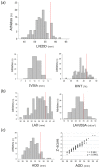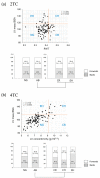Cardiac Structure and Cardiorespiratory Fitness in Young Male Japanese Rugby Athletes
- PMID: 36661907
- PMCID: PMC9861008
- DOI: 10.3390/jcdd10010012
Cardiac Structure and Cardiorespiratory Fitness in Young Male Japanese Rugby Athletes
Abstract
Limited data are available on athlete's heart for rugby athletes. This study aimed to investigate cardiac structure and its relationship with cardiorespiratory fitness in young Japanese rugby athletes. A prospective cross-sectional study using echocardiography and cardiopulmonary exercise testing (CPET) was conducted on 114 male collegiate rugby players. There was a higher prevalence of increased left ventricular (LV), atrial, and aortic dimensions in the young athletes than that in previously published reports, whereas the wall thickness was within the normal range. Anthropometry and CPET analyses indicated that the forwards and backs presented muscular and endurance phenotypes, respectively. Indexed LV and aortic dimensions were significantly larger in the backs than in the forwards, and the dimensions significantly correlated with oxygen uptake measured by CPET. On the four-tiered classification for LV hypertrophy, abnormal LV geometry was found in 16% of the athletes. Notably, the resting systolic blood pressure was significantly higher in athletes with concentric abnormal geometry than in the other geometry groups, regardless of their field positions. Japanese young athletes may exhibit unique phenotypes of cardiac remodeling in association with their fitness characteristics. The four-tiered LV geometry classification potentially offers information regarding the subclinical cardiovascular risks of young athletes.
Keywords: athlete’s heart; cardiopulmonary exercise testing; rugby; young athletes.
Conflict of interest statement
The authors declare no conflict of interest.
Figures


References
-
- Pelliccia A., Caselli S., Sharma S., Basso C., Bax J.J., Corrado D., D’Andrea A., D’Ascenzi F., Di Paolo F.M., Edvardsen T., et al. European Association of Preventive Cardiology (EAPC) and European Association of Cardiovascular Imaging (EACVI) joint position statement: Recommendations for the indication and interpretation of cardiovascular imaging in the evaluation of the athlete’s heart. Eur. Heart J. 2018;39:1949–1969. doi: 10.1093/eurheartj/ehx532. - DOI - PubMed
-
- Johnson C., Forsythe L., Somauroo J., Papadakis M., George K., Oxborough D. Cardiac structure and function in elite Native Hawaiian and Pacific Islander Rugby Football League athletes: An exploratory study. Int. J. Cardiovasc. Imaging. 2018;34:725–734. doi: 10.1007/s10554-017-1285-x. - DOI - PMC - PubMed
LinkOut - more resources
Full Text Sources

